To close off the year, I have a review of a pair of Danish Cold War forts, contributed by reader John Olsen, who previously wrote up the frigate Jylland.
In the early years of the Cold War, two coastal fortifications were built to close off Danish waters to Warsaw Pact maritime units. Both of them were closed after the Cold War ended, and both can be visited as museums today. This is a review of both museums, based on visits in 2023.
Stevnsfort Cold War Museum
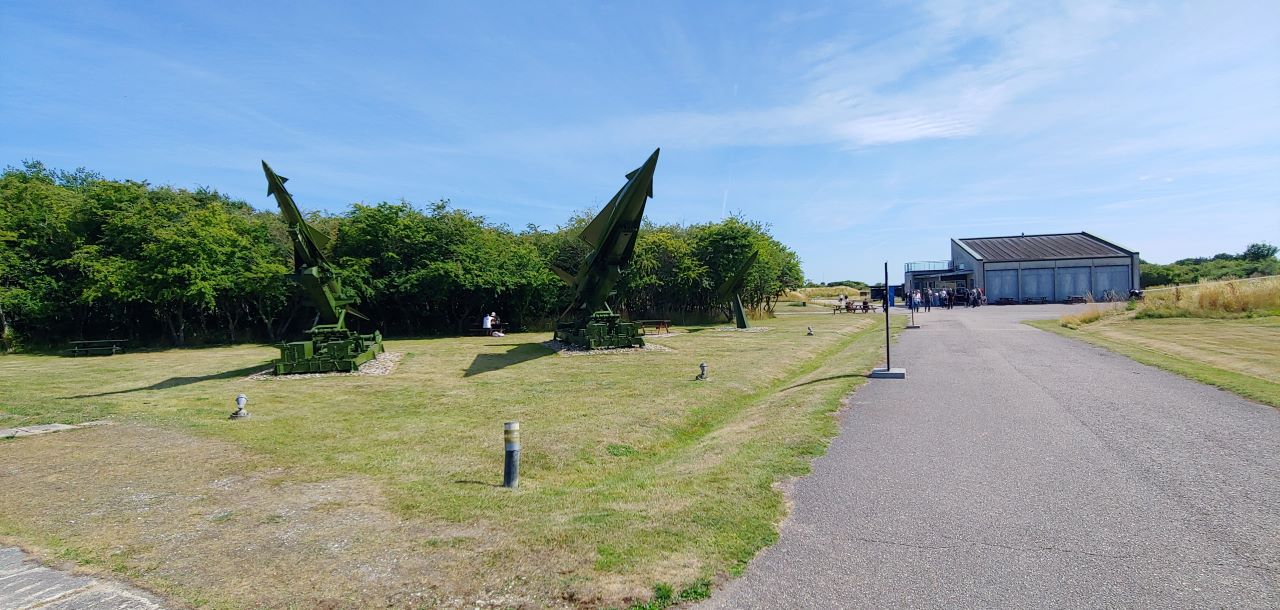
Introduction
Located well south of Copenhagen, the Stevns coastal fortification was one of two forts built in the early Cold War to close off Danish waters to Warsaw Pact maritime units. The primary armament of the fort consisted of two twin 5.9” guns from the WW2 German battleship Gneisenau, supplemented with 20mm and 40mm AAA guns. A HAWK SAM battery was added in the eighties (HAWK being an abbreviation for Homing All the Way Killer). Completed in 1953, the fort was formally closed in 2000, re-opening as a museum in 2008.

German battleship Gneisenau in 1942. Bundesarchiv, via Wikipedia.
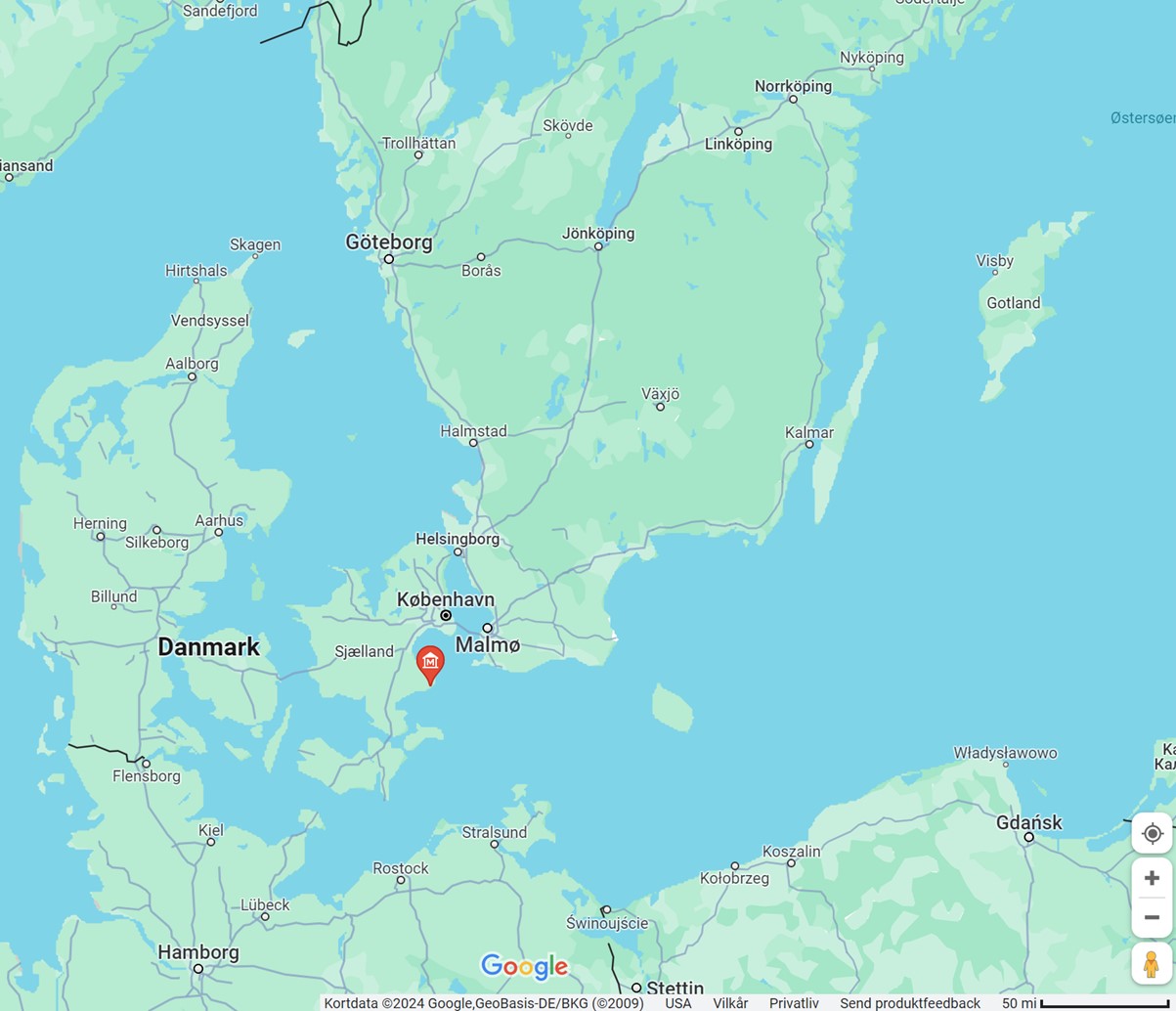
Map of Denmark, from Google Maps, with location of the Stevns Fort museum highlighted. The map shows the Baltic approaches to Denmark, as well as neighboring Sweden, northern Germany, and Poland.
Location and getting there
- The Stevnsfort museum is located approx. 1 hours drive south of Copenhagen (depending on traffic); parking at the museum is free. Alternatively, it’s some 3+ hours by public transport. Note that opening hours varies depending on the month; in 2024, the museum is closed in January, half of February, most of March, and in November-December. See the museum website for details and updates.
Bonus info: - There’s a Danish language documentary about life at the fort available at the website of the Danish national TV broadcaster. Although not subtitled, there are a fair number of images that give a good impression of life at the fort. At least for me, the link below also seems to work from the US.
If you happen to go see the museum, there’s a nearby lighthouse called “Stevns Fyr”. In addition to the lighthouse (which is open to the public), the surrounding area included support facilities for an air force HAWK battery. The military left the site a long time ago, but consider going there anyway – the view from the lighthouse is quite spectacular, and the former air force cantina now houses a small Danish café, which is well worth a visit if you’re hungry.
- Lighthouse website
- Café website
- Both Danish only, at the time of writing, but Google translate is your friend …
The cliffs in the area (“Stevns Klint”) are a UNESCO World Heritage site, as the coastal cliff has a highly visible chert layer formed from the ashes that resulted from THE meteorite impact 65 million years ago, itself leading to the mass extinction of dinosaurs.
The Stevns Fortress in the Cold War
During the Cold War, one of the primary responsibilities of the Danish armed forces was to be ready to close off Danish waters, thereby precluding the Soviet Baltic fleet from breaking out and joining the next Battle of the Atlantic. This strategy obviously required ships suitable for operation in coastal waters, but also thousands of mines. When the Cold War ended, the Royal Danish Navy included four Falsterclass minelayers (300 mines each), two Lindormenclass cable minelayers (50 mines each), as well as contingency plans to let train ferries double as additional minelayers.
The overall plan was to mine the belts, in some places with cable-controlled mines enabled or disabled from shore to create passages for allied ships as needed. Preventing the minefields from being cleared was a role for both surface ships, and the two coastal fortifications Stevnsfort and Langelandsfort (“fort” is Danish for … well, “fort”).
Construction of Stevnsfort was completed in 1953, with operational capability achieved in 1955. The fort was operated by the Royal Danish Navy, with an air force contingent added later to operate SAMs.
Gun armament consisted of two twin 5.9 inch turrets, both originally secondary armament from the German battleship Gneisenau. Gneisenauherself was under repair in Gotenhafen (now Gdynia) in early 1943, when Hitler ordered the cessation of work on the ship, as part of his intention to scrap the surface ships of the Kriegsmarine after the defeat at the Battle of the North Cape/Convoy JW51B, where Gneisenau’s sister Scharnhorst was sunk. Some of Gneisenau’s guns ended up in Denmark, for use in coastal fortifications to fight off a potential Allied invasion. It was these guns that would subsequently form the main armament of the Stevns and Langeland coastal forts.
The Stevnsfort was excavated from the chalk underground in the area. In addition to magazines for the guns, the underground facility included an operations room/command center, and accommodation for up to 250 personnel. Accommodation in the cave-like corridors of the fort were a bit austere, however, and the fort was only fully manned when placed on high alert during the Cuban Missile Crisis, as well as the Hungarian and Czechoslovak uprisings. For peacetime use, a set of barracks were built next to the fort. The barracks were built in the style of local farms, although the habitual outdoor parking of multiple military trucks probably did not help in making the deception effective to aerial photography. The barracks still exist, but are not open to the public, as they are used as a juvenile prison today.
In addition to the role of providing artillery coverage for planned minefields, the fort served as a local maritime command post. Hawk SAMs were added in the 1980s, and although these would obviously have been useful in protecting the fort itself, they were mainly installed to provide SAM coverage for Copenhagen and surrounding areas. Had the Cold War gone hot, it’s anybody’s guess how long the fort would have held out – Warsaw Pact plans uncovered after the Cold War showed that Stevnsfort would have been one of several targets for the plethora of nuclear devices intended to support the war.
The Museum
This review is based on two visits, during summer 2022 and 2023. Note that opening hours varies depending on the month; in 2024, the museum was closed in January, half of February, most of March, and in November-December. See the museum website for up-to-date details and updates.
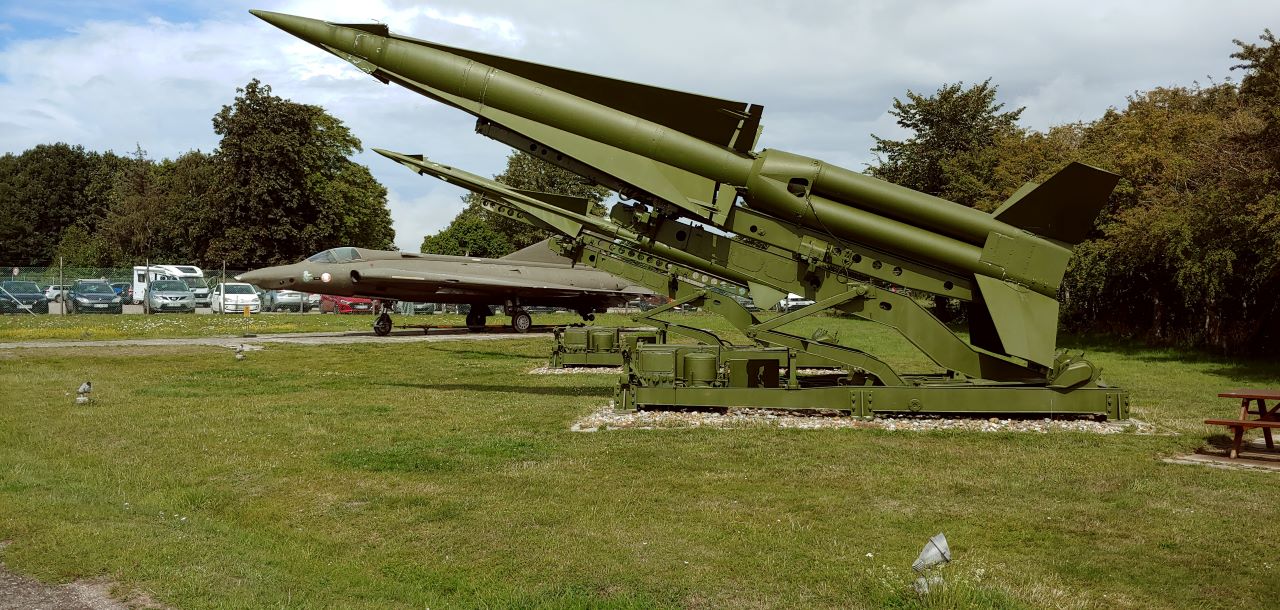
Past the museum entrance, looking back towards the parking lot. Note the SAAB RF-35 behind the Nike missiles.
Access to the museum is through an open gate, with a set of Nike Ajax, Nike Hercules and Hawk missiles acting as gate guardians, accompanied by a Saab RF-35, the reconnaissance version of the Swedish-built Draken double-delta wing fighter. There’s a small museum building with ticket sales, museum shop, a small exhibit of civil defence equipment and a couple of Cold War information films running on continuous loop.
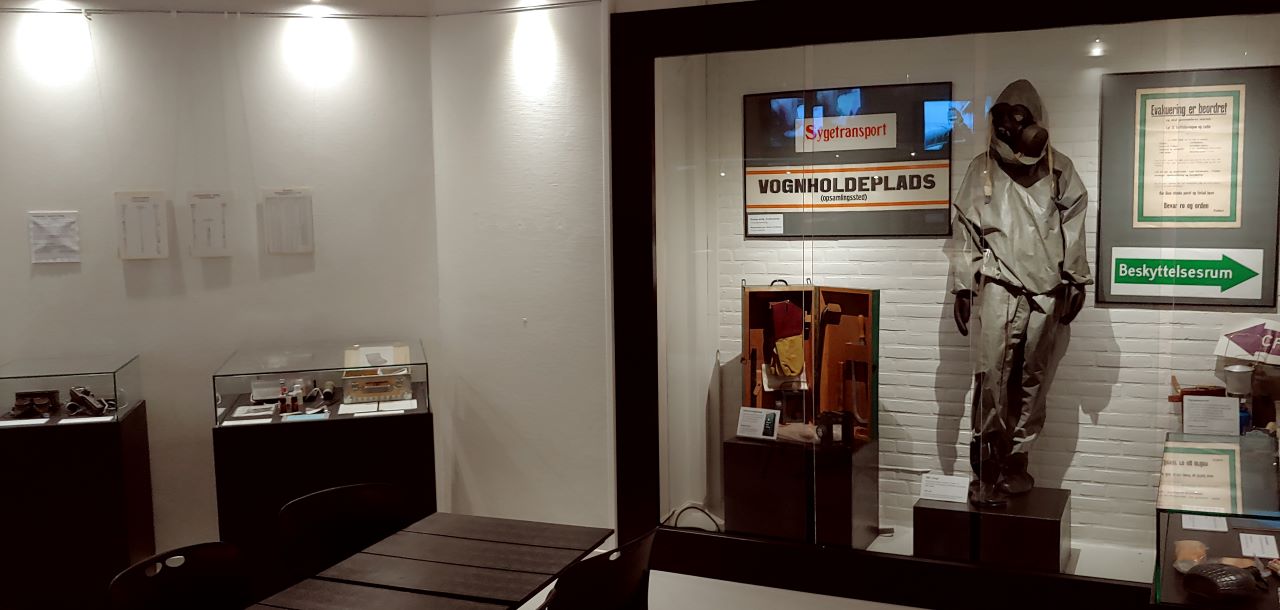
Protective equipment, information signs and radioactivity detection equipment is on display inside the small museum building.
However, the museum building is not the reason for visiting, the outdoor exhibit and the underground fort is.
The museum offers two types of ticket: A full ticket, including a guided tour through the underground fort, and a surface ticket only, at half the price. The surface ticket gives access to the outdoor exhibits of guns, missiles, radio and control vans for the SAMs, etc – but I’d really recommend you go for the full ticket, including the underground fort.
The full ticket also buys you a slot at one of the daily guided tours, starting at the museum exhibit. Book the tickets in advance online, to ensure your preferred timing. The tour takes the visitors past most of the outdoor exhibit, with a bit of explanation and Q&A to supplement the signs, available in Danish and English. Note that the underground fort can only be visited on a guided tour; there is no option to explore the underground facilities on your own.
As a practical matter, the guide speaks Danish, but is able to answer questions in English. For non-Danish speakers, the Useeum app offers info similar to that of the guides explanation along the route, in either English or German – one of the main disadvantage with the app is that it doesn’t have any of the personal anecdotes and perspectives that some of the ex-military guides offer, and you’ll spend the tour with a phone glued to your ear.
The guided tour starts in terrain, with a walk past different elements of the HAWK battery – control cabins, fire control, actual missiles, and various auxiliary vehicles.
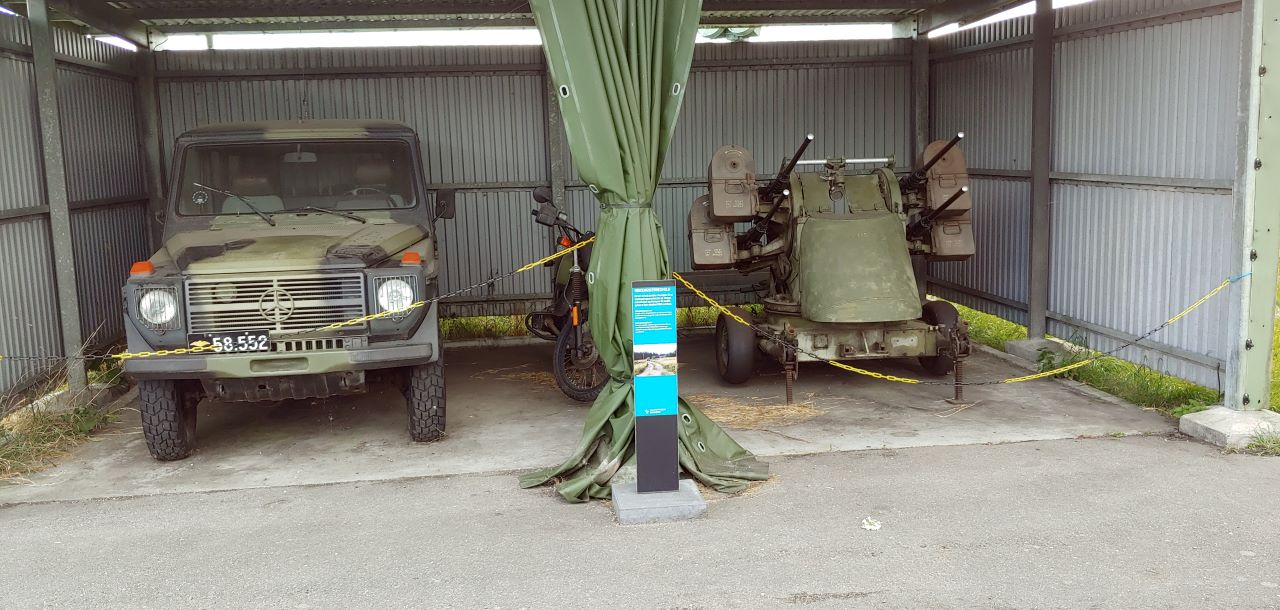
Vehicle, motorcycle and 20 mm cannon on display.
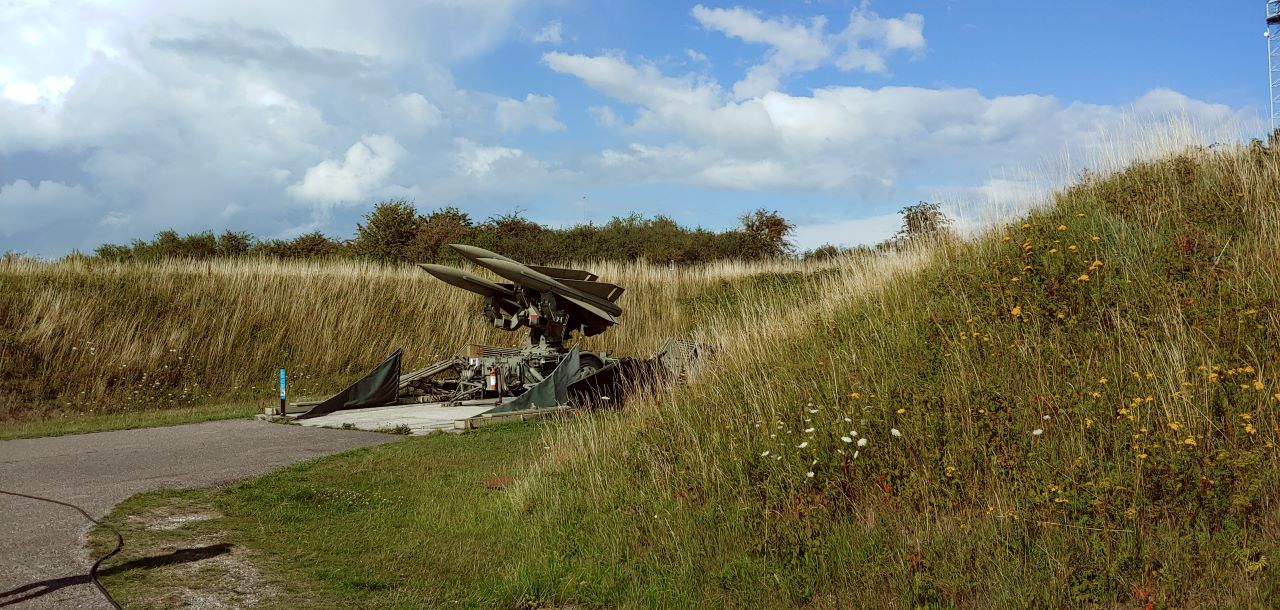
HAWK missile launcher, hiding in its revetment.
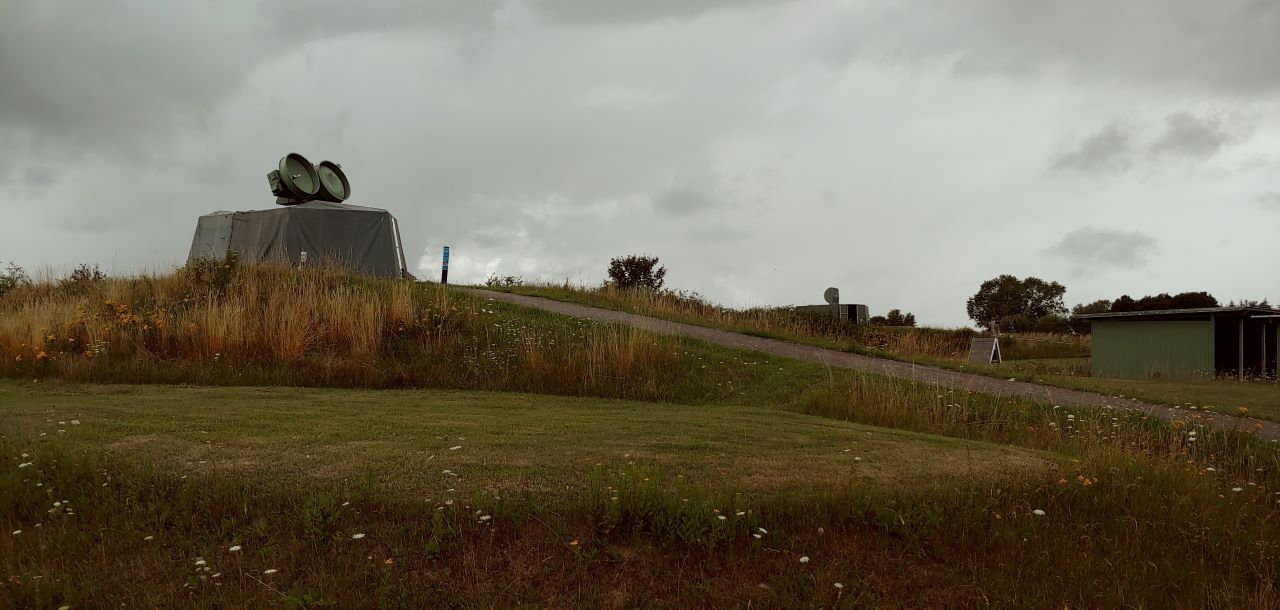
HAWK fire control radar.
The guided tour continues past the 5.9 inch guns, originally from the Gneisenau. The tour includes a visit inside the turret; the later underground part of the tour also includes a visit to the underground magazine.
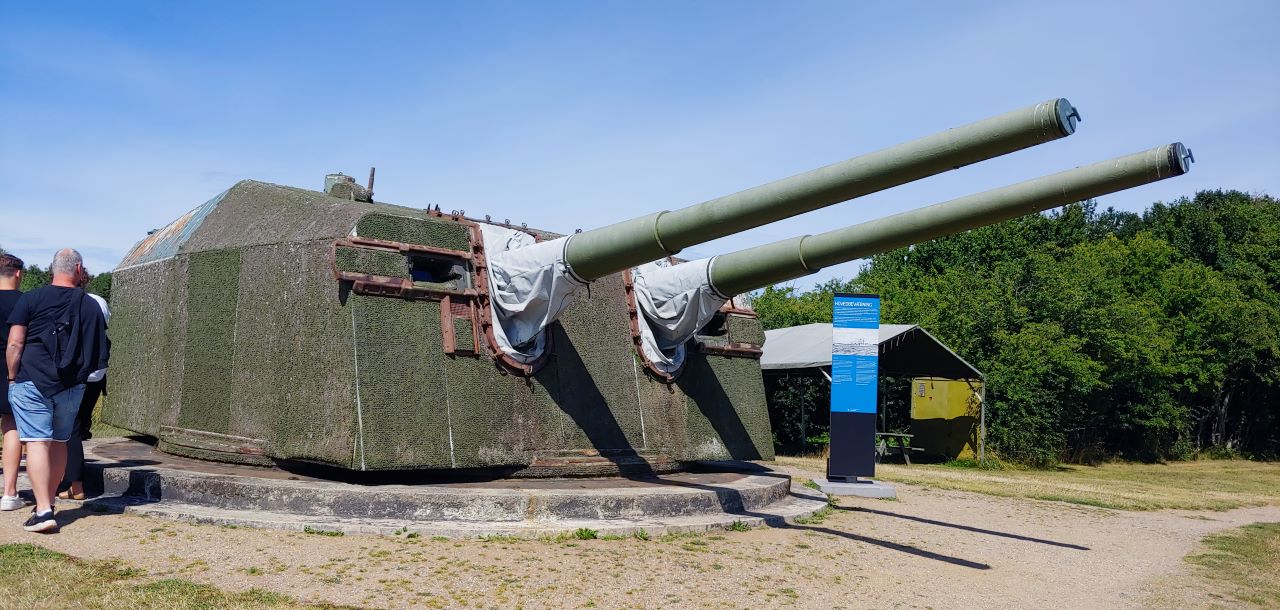
Tour group getting up close and personal with one of the 5.9 inch turrets. It’s rather cramped on the inside, especially with a full tour group, so I didn’t get any good pictures inside.
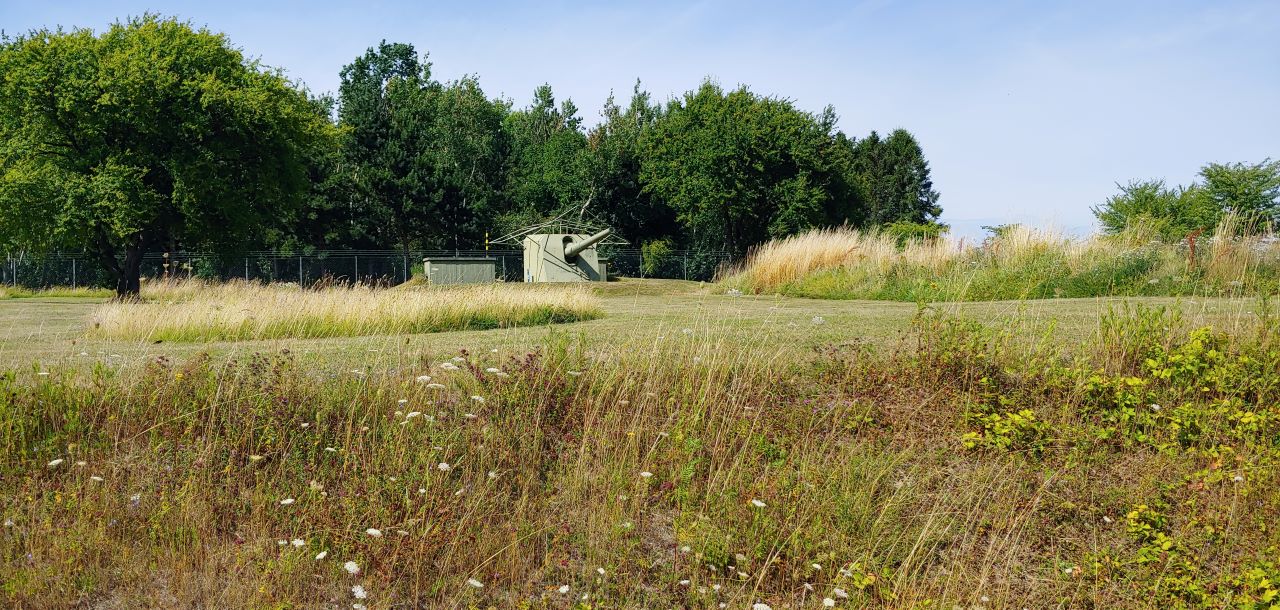
This single-barrelled gun was intended only for firing starshells, to illuminate targets for the main guns.
The main attraction, though, is to go underground and see the fort itself. As a practical matter, even if you’re visiting on a nice summer day, the underground corridors will be a bit chilly, and appropriate clothing is recommended.
The underground portion of the fort was laid out with a command centre and two similar underground sections, each section supporting one of the 5.9 inch turrets. The underground tour covers the command centre, one of the underground sections supporting a 5.9 inch turret, accommodation areas (mainly bare when I visited) and long stretches of tunnels (where a lot of the personnel would have slept on fold-down cots, if unable to return to the surface accommodation). The other section would be nearly identical, and is not open to the public.
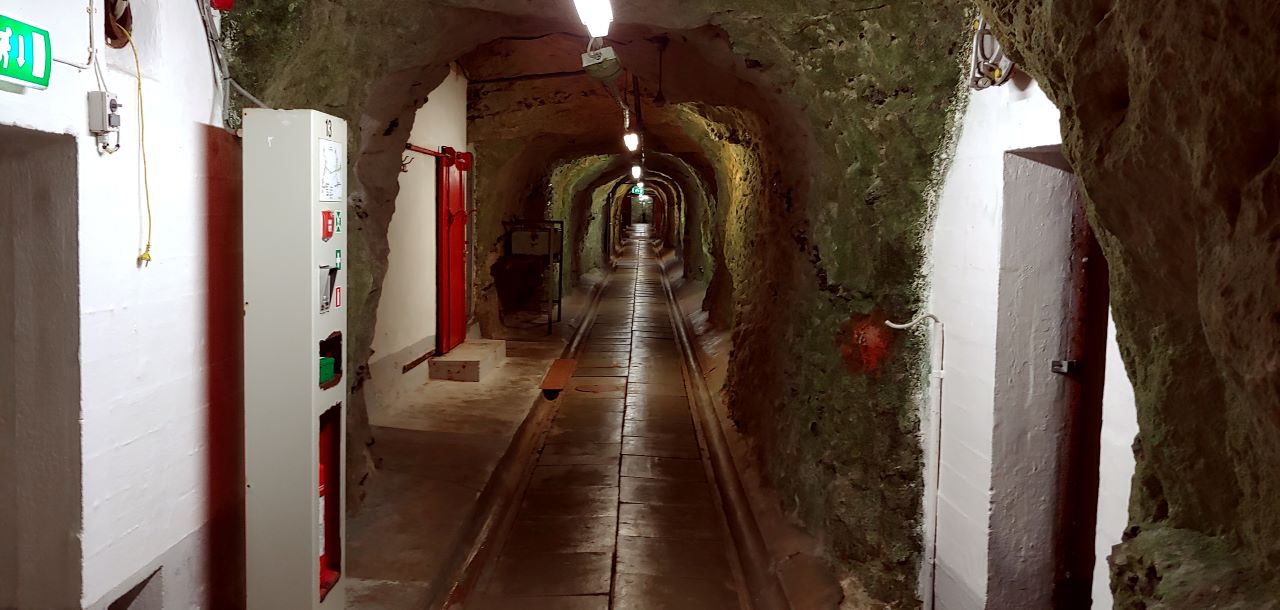
The tunnel walls in the fort are mostly bare chalk, with a mostly-green growth covering the otherwise white rock.
The museum has made an effort to make key components of the fort appear as they would have when the fort was active. The command centre includes radar terminals, teleprompters, code machines, and a break area complete with adult magazines from the period.

Teleprompters and code machines are on display in the old communications centre.

Surveillance center with radar screens. One of the chairs in the centre was always manned by a Swedish liaison officer, although this was not widely publicized, given Sweden’s ostensibly neutral stance during the Cold War.

The fort featured a landing for small boats, via an open entrance leading to a closed door further inside the tunnel. On various occasions, East Bloc commandos would pay a visit, sneaking in and placing a bottle of alcohol, or other souvenir, close to the door.
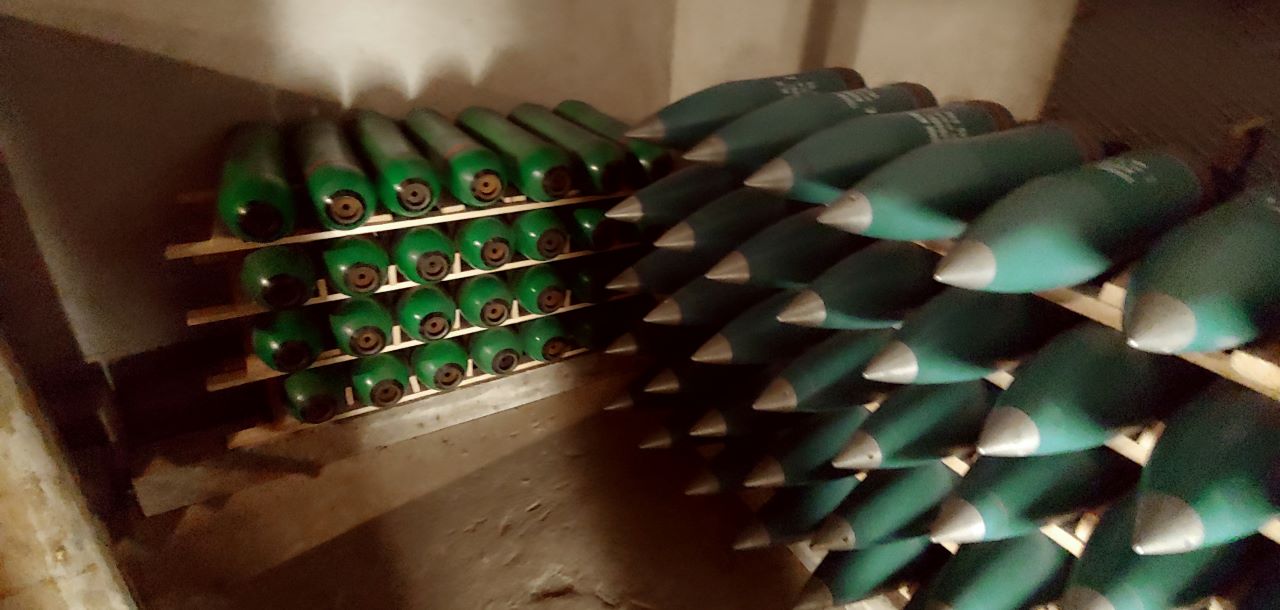
5.9 inch shells for one of the two turrets. All ammunition for the fort was originally made in Nazi Germany, as a) there was a plentiful supply, b) the guns were only fired once a year. The blast from the guns tended to damage windows in nearby civilian houses, hence practice firings had to be announced well in advance, to allow mitigation..
Once back on the ground, there’s time to have follow-up questions with the guide – both the guides I’ve tried were very talkative and eager to answer questions. Options to ask questions during the tour may be limited, as the tour itself has to maintain a certain pace, to avoid having two groups of visitors in the same space.
The good and the bad
The good:
- Unique Cold War coastal defense site.
- Short tri-lingual (Danish, German, English) description of displayed items for the surface
portions of the tour.
- Full HAWK battery on site.
- Ex-Nazi guns, repurposed to fight Bolsheviks – what’s not to like?
- The two guides I’ve tried both gave a good and lively account of the role of the fort, life at the fort, and a few well-chosen anecdotes to make history a bit more lively.
- There’s an audio tour available, both for a self-guided tour of the surface, and the underground sections.
The bad:
- As good as the guides are, the reliance on the guides for especially the underground part of the tour is also a bit of a weakness. Both the guides I’ve tried spoke Danish, and either relied on non-Danes using the English-language pre-recorded audio tour, or gave very short English versions of the Danish tour. You can try insisting on your guide repeating each story in English, but they’ll probably be pressed for time - If possible, you’re better off allying yourself with a Danish speaker fluent in English, to do the live translation for you. Or, try to catch up with the guide after the tour is over, to fill you in on the details.
- Many segments of the underground tour feel bare, without furniture or equipment otherwise, except for the command centre and adjacent areas, and the gun turret and magazine. E.g. informational/illustrated posters and/or mannequins and their surroundings would have helped to bring more parts of the underground fort alive. The surface exhibition could also benefit from a bit more context on the Cold War – this is something the Langelandsfort (reviewed separately) does rather better.
The verdict
If you’re in the Copenhagen part of Denmark, or in nearby Sweden, and the time of the year works for you, I’d definitively recommend visiting. The location really requires you to have access to a car, and if you’re there, you might want to expand your visit to a general tour of the area (see suggestions earlier). The main limitations of this museum is really that you’re very dependent on the guide for a good experience, and that the Langelandsfort does a more expansive and well-rounded delivery of a similar story – but the Langelandsfort will probably be even more inaccessible to potential visitors, given its more remote location.
Langelandsfortet Cold War Museum
Introduction
Located on the southern end of the island of Langeland (the name literally means “long land”), the Langeland Fortress opened in 1953. Like the Stevns Fortress, the Langeland installation was equipped with 5.9” guns from German battleship “Gneisenau”, also supplemented with 20mm and 40mm AAA. The armaments of the fort were mothballed in 1973, but the operations bunker and support facilities continued in use until decommissioning in 1993.
The Langeland Fortress in the Cold War
The Langeland Fort had a role not too dissimilar to that of the Stevns Fort. However, the terrain and geology of Langeland is much different from Stevns. Whereas the Stevns Fortress was an underground facility excavated from chalk layers, the Langeland installation consisted of a series of separate, mutually-supporting bunkers. The main armament consisted of four 5.9” guns from the Gneisenau, which at Langelandsfortet were installed as single guns in four widely separated bunkers. An operations bunker coordinated the actions of the different artillery units, and also served as a local maritime command post, monitoring all traffic in the area of responsibility. The nearby estate “Holmegaard” was acquired by the military, to be used as peacetime accommodation for the approx. 400 men manning the installation. “Holmegaard” was sold off separately and is not part of the museum; the estate has been used since then mainly as temporary accommodation for refugees, most recently for Ukrainians.
Serving at the Langeland Fort was (incorrectly) perceived to many to be a special kind of punishment, reserved for the misfits of the Danish Navy. This perception mainly stemmed from the fact that the fort was located far away from major towns, offering limited opportunities for nightlife for the young conscripts making up a large part of the personnel. Indeed, you’re probably not going to visit the museum unless you happen to be in the neighborhood: it’s approx. 2½ hours from Copenhagen by car, and just over an hour from Odense.
Unlike the Stevns Fort, which had Hawk SAMs added to help defending the capital area, Langeland Fort did not receive SAMs.
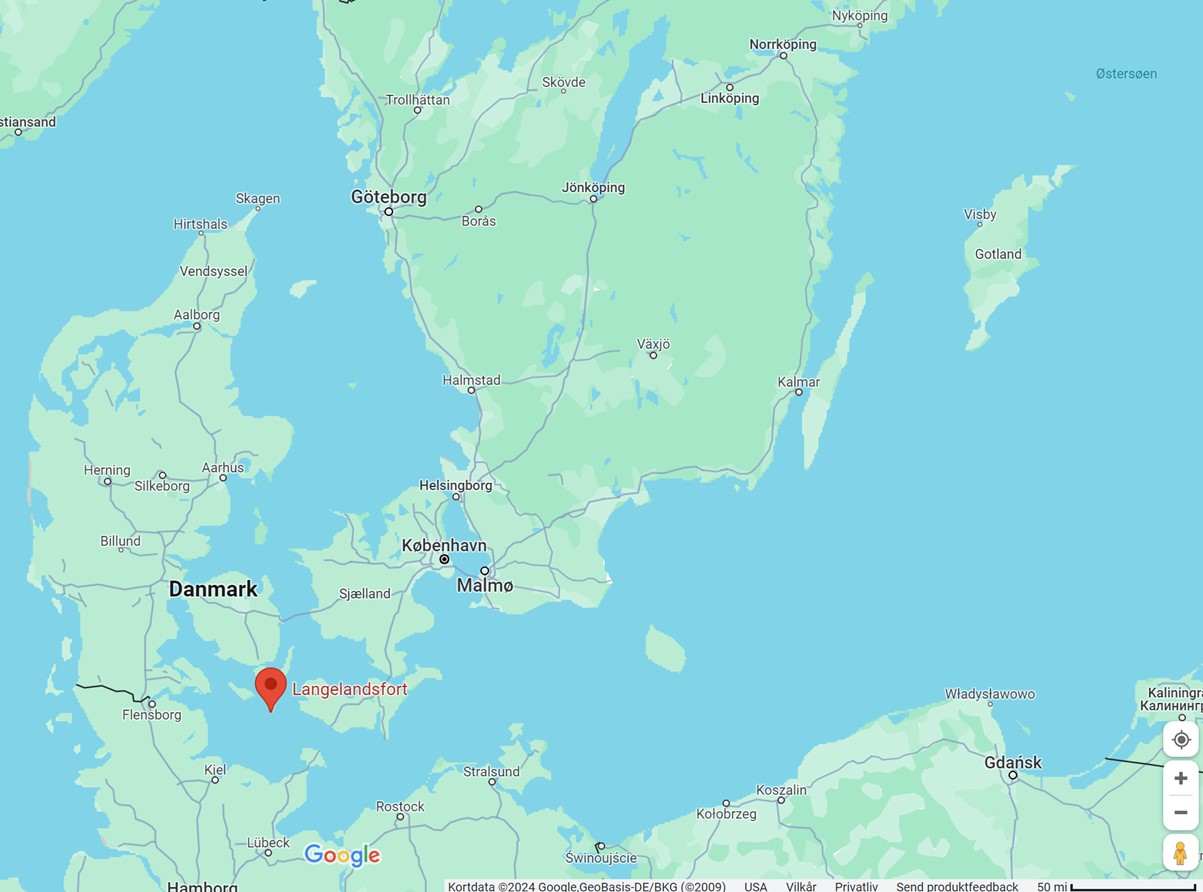
The museum
The museum is open from 1 April to 31 October. Once the ticket is paid, you’re off to explore on your own – or you can ride a light truck that drives around the perimeter.
The Langelandsfort Museum is presented as a general Cold War museum. Entrance to the fort grounds brings you past a series of posters that give a brief summary of the Cold War highlights. After that, the perimeter road brings you past all the main elements of the old fort.
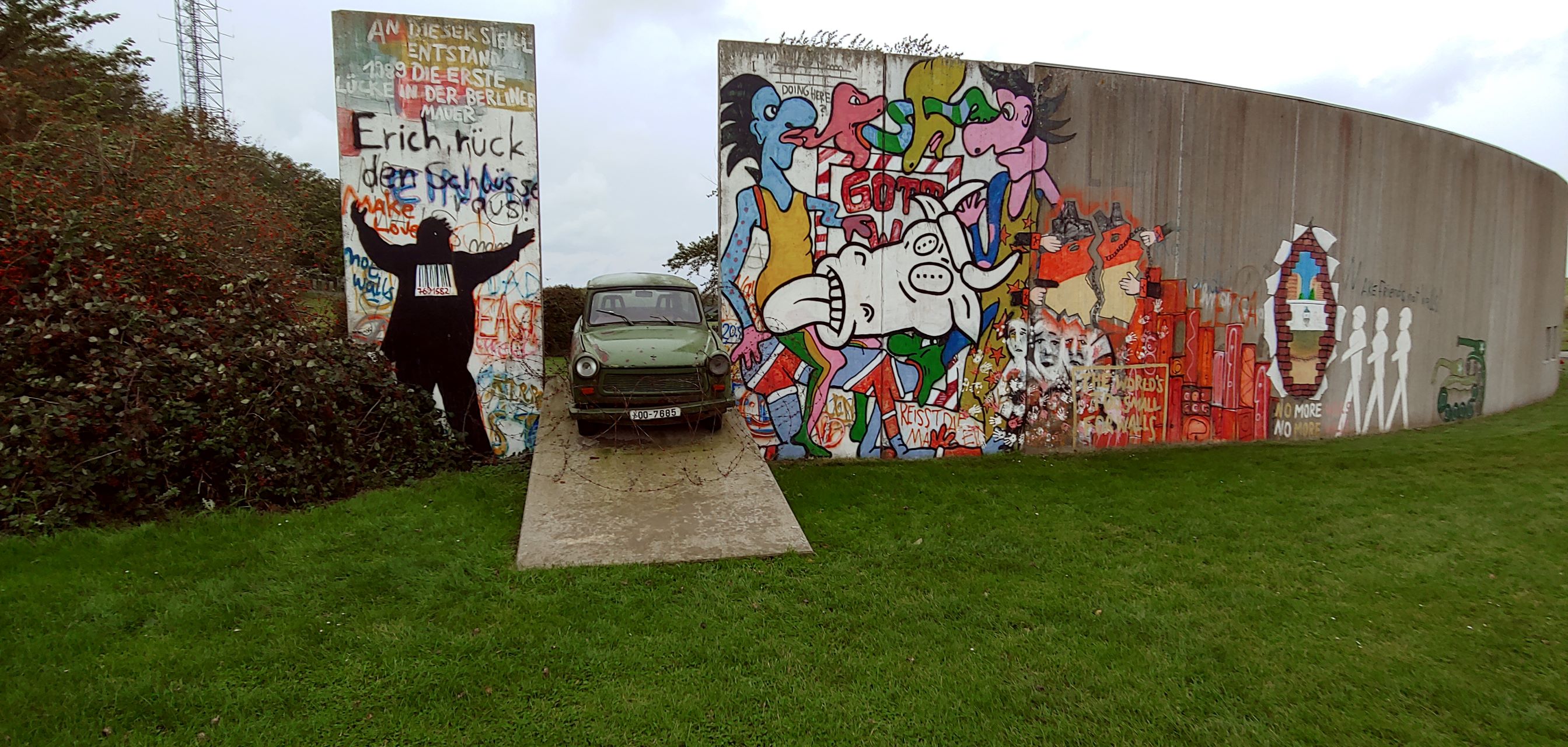
Visitors are greeted with a bit of 1989 Berlin Wall nostalgia, including a Trabant. The Trabant was an East German car, primarily sold in East Germany and Eastern Bloc countries. Typical waiting time to get one in DDR was some 10 years for the average citizen.

Access road to the fort, with posters giving a timeline of the Cold War.
The operations bunker is the first building encountered once the museum is entered. The bunker looks fairly close to being in actual use, thanks to being fully equipped with radios, maps, binders, and uniformed mannequins. Plexiglas plates are used to ensure that visitors don’t touch the exhibited objects.
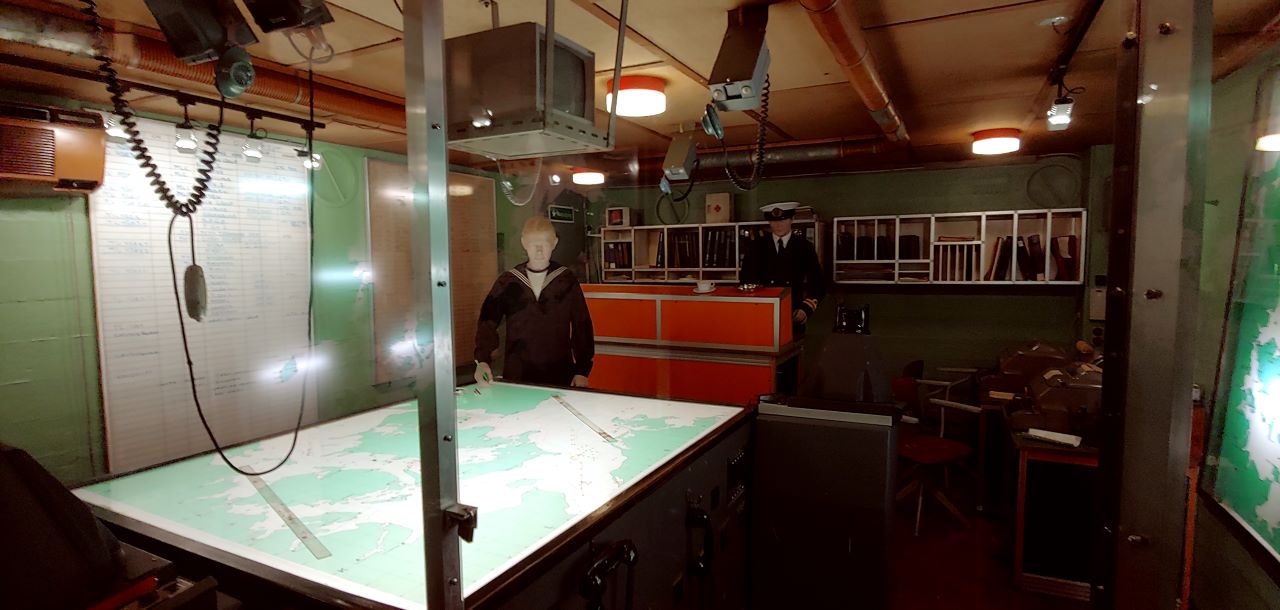
Operations bunker.

Cold War high tech information technology.

AAA mount. The barbed wire is a neat way to keep visitors from touching the exhibited weapon.
The old Gneisenau guns were installed in four single mountings, each mount with its own bunker underneath. Bunker 1 gives a faithful attempt at recreating life in the bunker, with reconstructed accommodation, dummy artillery shells, and uniformed dummies. Additional placards and exhibits tell the story of life as a seaman serving at the fort.
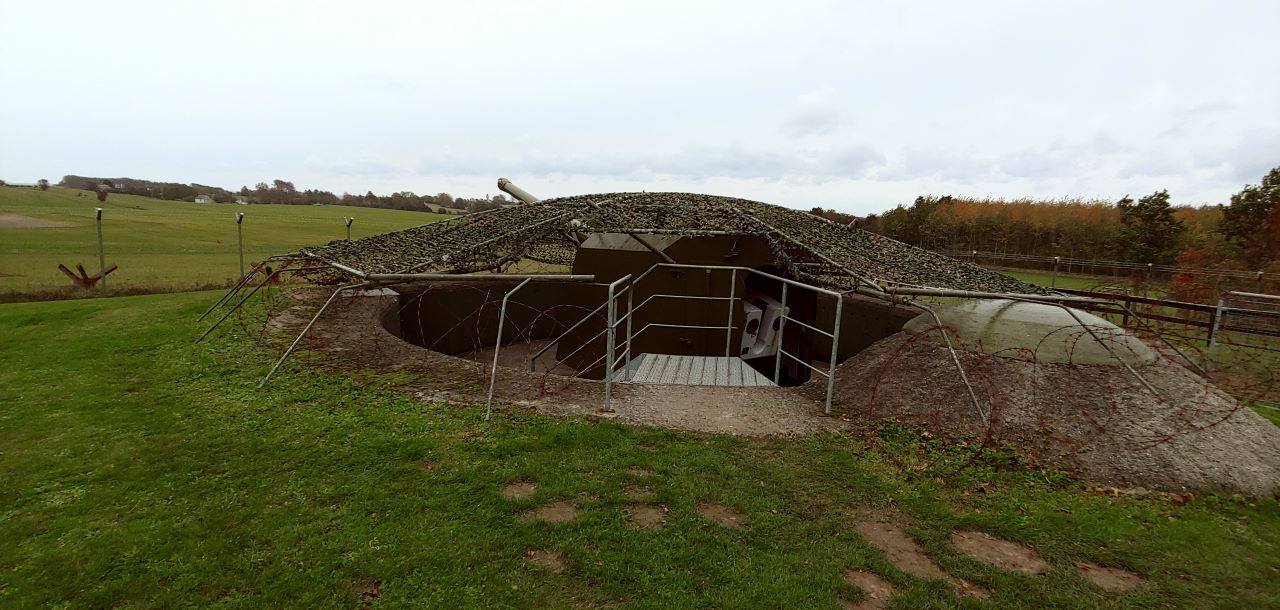
Entrance to Bunker 1, with the 5.9 inch barrel visible.

Bunker 1 ammunition hold.

Bunker 1 interior.
Instead of just repeating the same recreations in the subsequent bunkers, each artillery bunker is used for a differently themed exhibit. Bunker 2 tells the story from the Warsaw Pact perspective, describing plans and preparations for the invasion that never came.
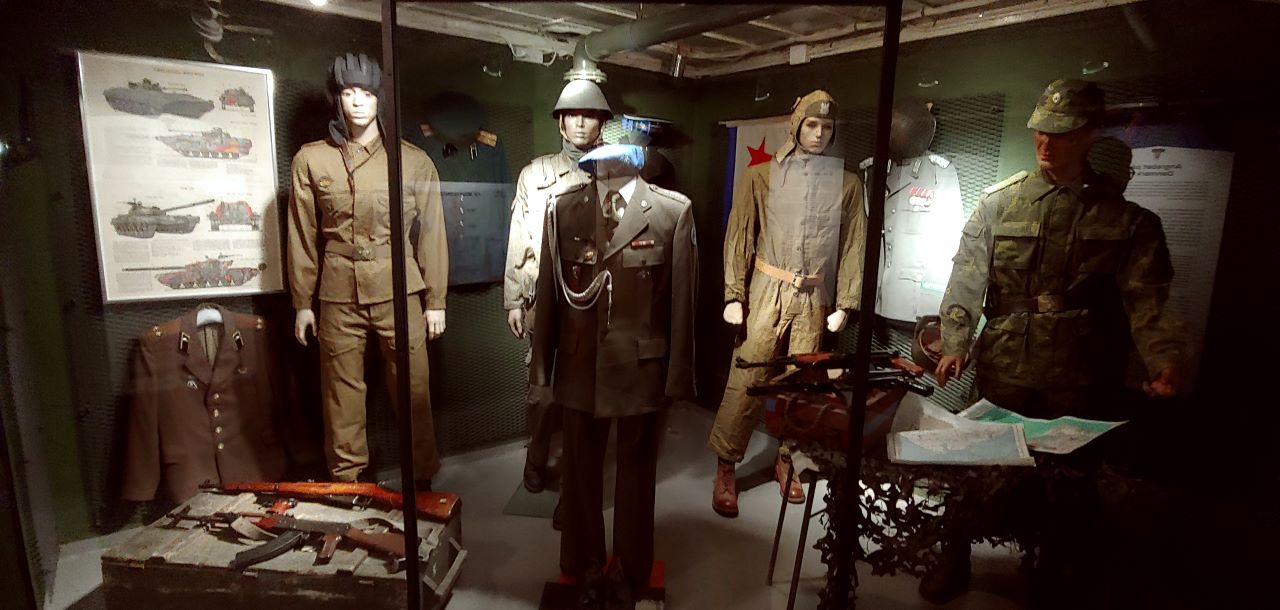
Warsaw Pact uniforms and equipment on display in Bunker 2.

The Blücher Medal was prepared specifically for being issued by the East German armed forces, should the Cold War have gone hot.
Bunker 3 tells the story of the Danish naval special forces, the Frogman Corps, since its start in the early Cold War, up to present day anti-terrorism and anti-piracy tasks. Finally, Bunker 4 is dedicated to an exhibition on the propaganda efforts during the Cold War (which, due to being a bit pressed for time, I was unable to visit).
The museum goes beyond the scope of just presenting the fort and its place in the Cold War. The fort also includes the ex-Danish submarine Springeren. Springeren was built as Kya, one of 15 Kobben class submarines built for the Norwegian Navy, based on the German Type 205 design. Kya transferred to Denmark in 1991, serving until decommissioning in 2004. Confusingly, the previous submarine named Springeren served the RDN from 1964 to 1990 and is today also preserved as a museum in the city of Aalborg.

Approach to Springeren.
Like the bunkers, a lot of effort has gone into making Springeren appear like a living submarine, with uniformed dummies and plenty of interior details added. It is well worth a visit on its own, even if onboard signage is somewhat limited (and the cramped nature of a coastal submarine makes it challenging to take good interior pictures).
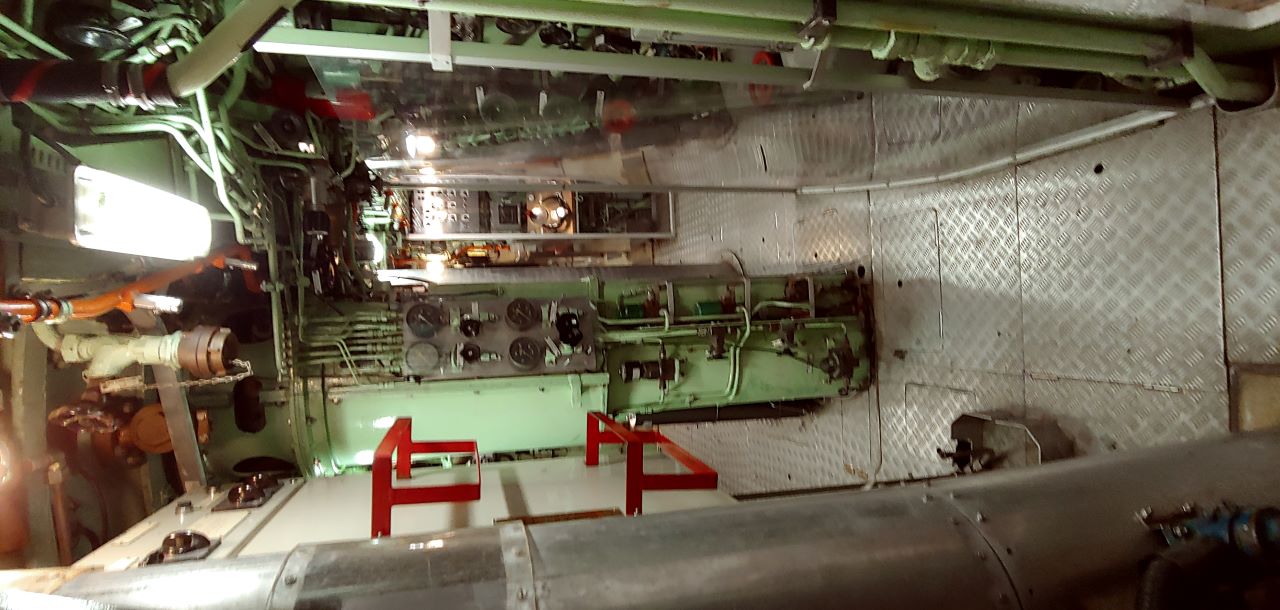
Springeren interior.
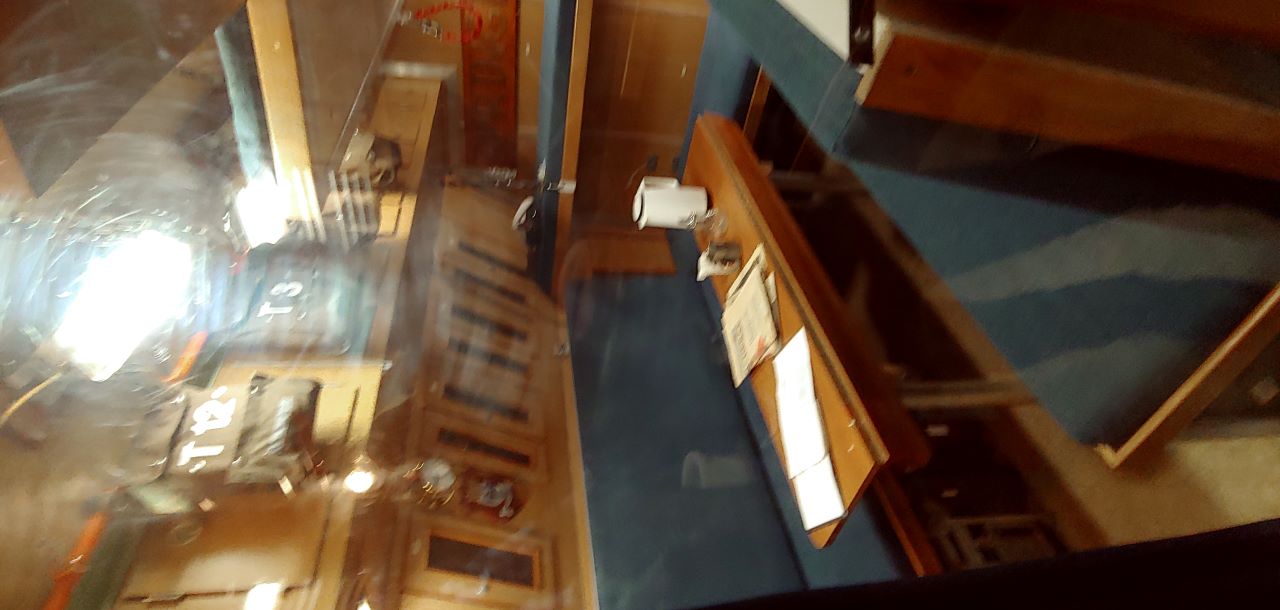
Springeren wardroom. The image is a bit fuzzy due to a plexiglas plate separating the interior from visitors.
Another maritime exhibit includes the Askø, a minesweeper commissioned in 1941 and served as such until transferring to the Danish Naval Homeguard in 1965, finally decommissioning in 2004. Askø is housed in a hangar that also includes an exhibit of naval mines in Danish service. Again, the ship itself is well preserved, with various items and uniformed mannequins distributed around the ship to give a feel for being on an actual operational ship.
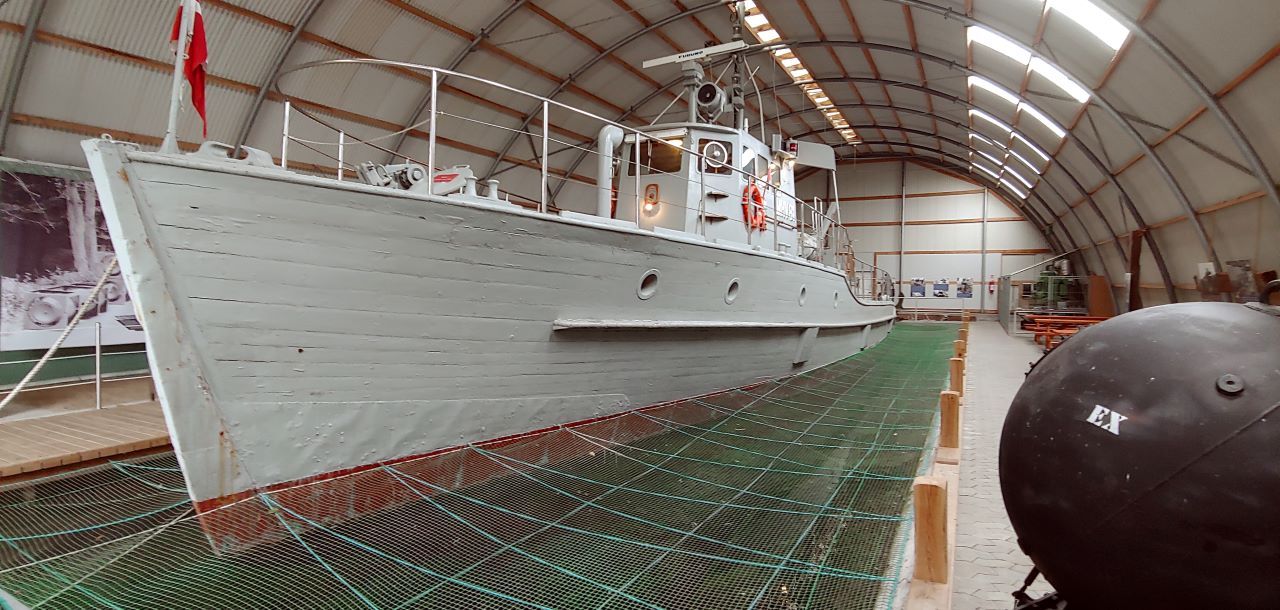
Askø, previously a minesweeper. The building in which it is located includes an exhibit on mine warfare. Askø itself is, however, presented in its role as a patrol vessel of the Danish Naval Home Guard, with which she served from 1965 to 2004, primarily in surveillance and SAR duties.
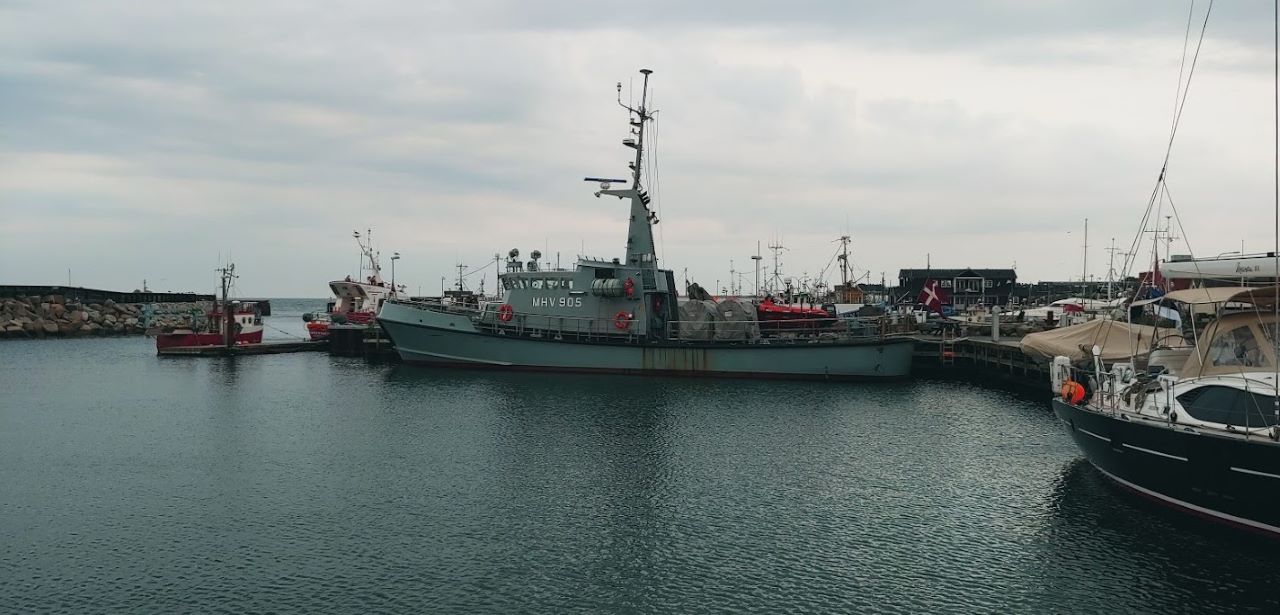
Today, the name Askø is used by another patrol vessel of the Naval Home Guard. For illustration, this is the present Askø, photographed in 2021. Rather than making do with civilian and naval cast-offs, the Naval Home Guard has mostly used purpose-built ships since the 1990’s.
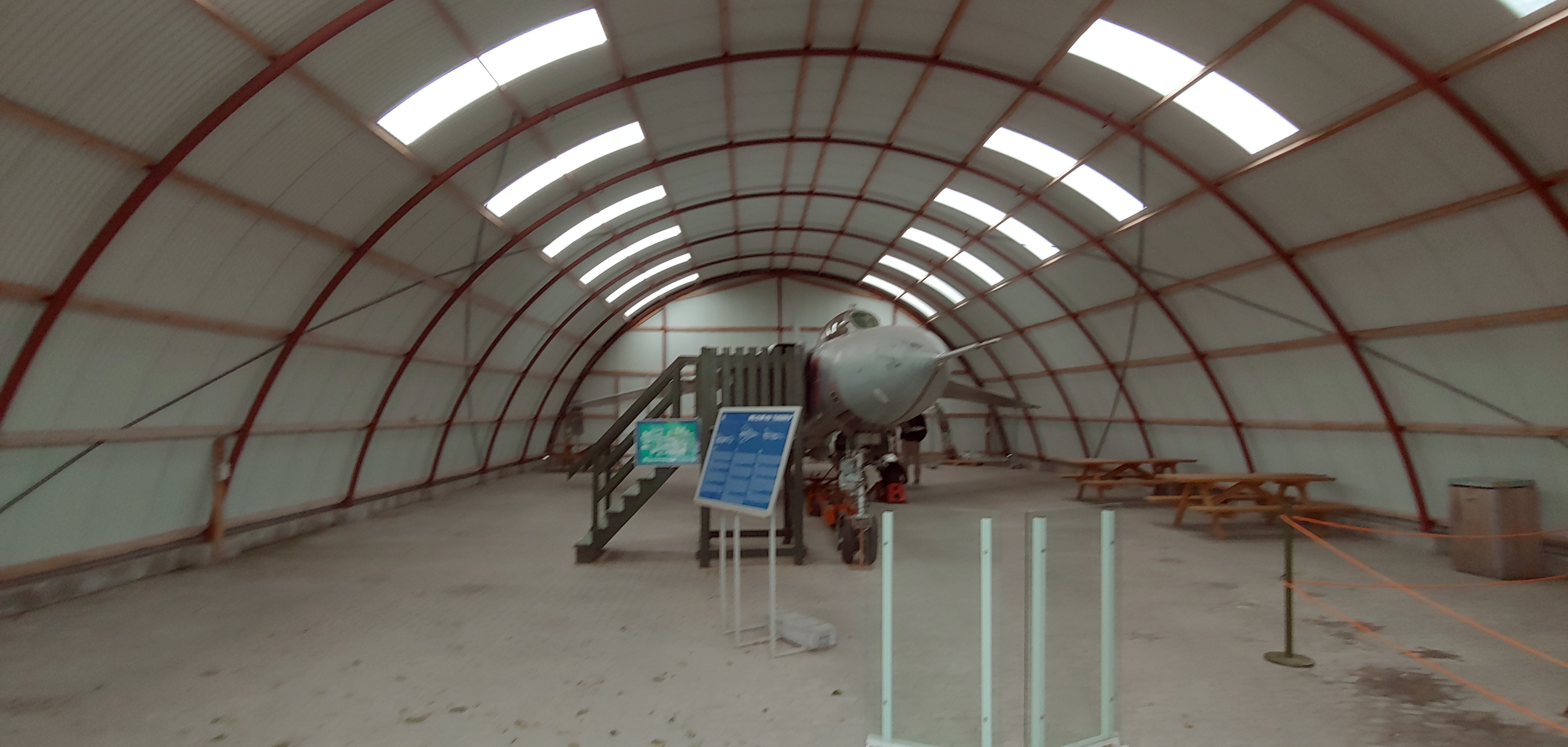
The museum also includes a MiG-23.
The good and the bad
The good:
- Unique Cold War coastal defense site, expanded to serve the role of a general Cold War museum.
- Short tri-lingual description of most displayed items (Danish, German, English).
- A lot of effort has gone into giving the visitor an idea of how the fort appeared while in operation.
- Submarine, ship, mine warfare, naval special warfare exhibit, and the ones I missed out on due to lack of time.
- Explanatory signage, context.
- If you have to make a choice between the Stevns and Langeland fortresses/museums, Langeland is the one I’d go for.
The bad:
- I’ve been there once, at the tail-end of the season, and didn’t really encounter any guides once we’d bought our tickets, so it’s very much a self-guided tour.
- Otherwise, accessibility is the only thing to complain about – the museum is quite a bit off the beaten path.
Thanks again to John for his very thorough reviews of a pair of museums that seem tailor-made for my interests, and that I very much hope to visit some day.

Comments
You mentioned Warsaw Pact Plans for what would have been WW3. Any way you can do a posting about that. There is some info out there on "7 Days to the Rhine", but after that there is not much.
And very little on Nato plans for WW3 (other than Reforger operations which are impossible to keep secret).
You mentioned Warsaw Pact Plans for what would have been WW3. Any way you can do a posting about that. There is some info out there on "7 Days to the Rhine", but after that there is not much.
And very little on Nato plans for WW3 (other than Reforger operations which are impossible to keep secret).
These Cold War forts are fascinating glimpses into Denmark's strategic role during that tense period. The Stevnsfort sounds like a unique experience, especially with the underground tour, though the reliance on guides and sparse exhibits could be a downside. Langelandsfort seems like it might offer a more immersive experience with its varied exhibits and well-rounded Cold War focus. Would love to visit both someday! Thanks for the thorough review!